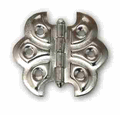Installing hinges on a flush door surface will leave you with several choices when choosing how you want your doors to look and how you want them to be mounted. Below are several of the most common hinges you will want to use. Each describes its uses and advantages. Click pictures to purchase. New window will open.
A Surface Mount Hinge has both leaves secured to the surface of the door and frame. It is one of the easiest hinges to install because you don’t have to chisel out a mortise. A surface mount hinge is normally decorative and referred to by its design or shape, as in "butterfly" or "H" hinge. Round head screws are recommended for mounting.
Butt Hinges are the most commonly used hinges when it comes to mounting residential doors. This is the "utility" hinge of cabinetry and construction. Plain and functional.
- In a typical installation, butt hinges will have to be mortised. Only the knuckle will show.
- When installing cabinet doors, butt hinges can be surface mounted, but they are slightly ugly mounted this way. Flat head screws are used for mounting
Barrel Hinges are completely invisible when a flush mounted door is in the closed position. The hinge is only visible when the door is in the open position. This is a great hinge to use if you want to give your cabinets a smooth, clean look. This usually requires thick doors. Barrel hinges fall into the "specialty hinge" category as well and we only carry two diameters, both of which are a typically usable size, which are 14mm and 12mm.

A Pivot Hinge is a hinge that pivots on a single point. Only the single pin on top and bottom supports the weight of the door, so depending on the weight of the door, panels wider than 18-20" are not recommended. The length of the door, however, is of less concern. This style hinge is typically seen on entertainment centers using a variation that holds a glass panel.
 We have several variations of pivot hinges in several categories, but they all pop up really easy by typing "pivot" into our search bar.
We have several variations of pivot hinges in several categories, but they all pop up really easy by typing "pivot" into our search bar.
Two leaf hinges consist of two independently pivoting leaves that will rotate 360 degrees. These are sometimes used as a non-mortise butt hinge. But, more often, these are used as a swivel for a framed mirror hanging in a yoke as in a dressing mirror or a vanity mirror.

Non mortise butt hinges are used to avoid the need to cut a mortise into the wood door and frame. Since one leaf fits inside the other, the thickness of the hinge is reduced sufficiently to allow a very small space between the cabinet door and the frame similar to what is common to a mortised mounting.





